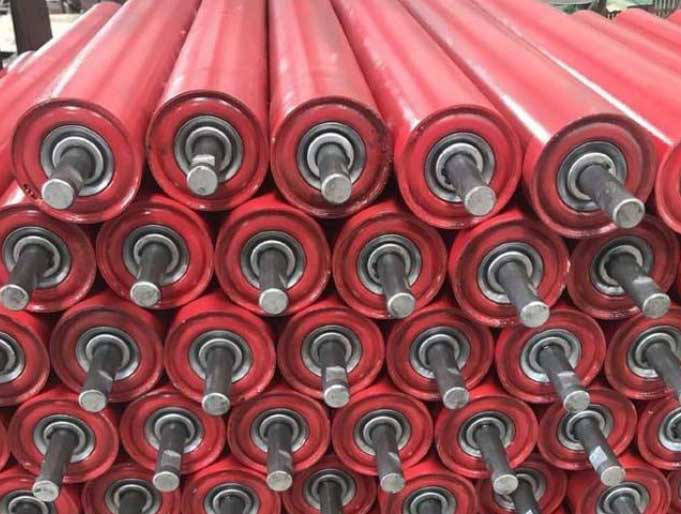
(1) Prevent the belt from mistracking or self-aligning idler
1) Self-aligning idler with vertical roller. It is composed of vertical shaft, trough idler, idler support, etc. Vertical shaft
The main function is to prevent the tape from misaligning, and to adjust the center by the friction generated by the tape.
2) Differential flex roller type reversible self-aligning idler. It is composed of cylindrical rollers, conical rollers, roller group rotating brackets, etc. When installed, the small head of the conical roller is upward, and a cylindrical roller forms a trough bracket group. When running, the conical cone will produce a speed difference, and there is friction, which can make the bracket rotate at a certain angle, thus playing the role of self-alignment.
3) MT type reversible self-aligning idler. It is mainly composed of curve rotation device, side, middle and bracket rotation support, etc. Two curved whirlwinds are installed on both sides of the side rollers, and together with the middle rollers, they form a trough bracket. In the process of operation, when the tape deviates, the tape is in contact with the curve gyrator, which will produce friction, and when the friction force is greater than the deflection force, coupled with the effect of the rotating bracket, the tape can be automatically adjusted. With this type of conveyor, there is very little wear on the edge of the belt.
4) Anti-deviation spiral roller. It is composed of spiral idlers, brackets, bearing seats, etc. The spiral idler is divided into two rotation directions, left and right, and is generally made by tightly sleeved spiral processing on the round roller. This trough roller set is mainly composed of spiral rollers and cylindrical rollers. The spiral idler tape is kept in the center of the bracket during operation to prevent mistracking 5) Self-aligning idler with spiral groove. Because of the spiral groove on the surface of the roller housing, when the tape is run on it, a thrust perpendicular to the direction of movement of the belt is generated, causing the tape to automatically adjust to the center position.

(2) Idlers of large inclination conveyors
1) Double-row staggered V-shaped deep groove idler set. Two pairs of brackets are symmetrically inclined to both sides, and are staggered in two parallel planes, wherein the lower end of the middle pair of idlers overlaps the staggered star V-shape, and the other end overlaps and intersects with the lower ends of the idlers on both sides respectively. Such a structure can increase the friction between the material and the conveyor belt, thereby increasing the allowable inclination angle of the conveyor, and is suitable for transportation at large inclination angles.
2) Deep groove idler group: mainly composed of two long and two short idlers, two short idlers are installed below, and two long idlers are respectively installed above the short idlers to form a trough idler group, in which four bracket axes are located in the same plumb surface.
(3) Non-metallic roller idler
Non-metallic rollers refer to rollers made of non-metallic materials, which are mainly designed according to the conveying environment, because the characteristics of the rollers are different because of the different materials used to make them. This kind of pallet can be used in chemical industry, metallurgical mining, salt industry, textile and other transportation occasions.
1) Ceramic roller: made of ceramic material, with good corrosion resistance and wear resistance.
2) Enamel idler: steel porcelain composite material processing and manufacturing with metal as the base material and enamel on the surface. This roller has high mechanical strength, wear resistance, corrosion resistance, waterproofing and dustproof.
3) Flame retardant rubber roller: The roller roller is composed of a flame retardant rubber layer inherent in the outer surface of the metal cylinder, which can effectively prevent the roller from catching fire due to friction and heating.
4) Non-metallic impact-resistant rollers: The roller is made of antistatic charge flame retardant materials, the impact-resistant tensile spring mechanism is installed inside the support, and the two ends of the roller are labyrinth sealed, which has the characteristics of impact resistance, corrosion resistance, wear resistance and so on. Due to the variety of types of conveyor rollers, there are many problems when designing the rollers. The main problems are:
1) There are many kinds of supporting goods on the market now, and the structure and manufacturing materials are different, resulting in great differences in performance, and the rollers with good performance can be used for more than 10 years: the rollers with poor performance can only run for a few days. Prices vary widely, ranging from thousands to hundreds of dollars. How to choose an idler with reasonable price and good performance is the first problem faced by users.
2) In the conveyor structure, how to reasonably arrange the idler is also a problem that must be considered. The number of idlers directly affects the conveying performance and operating cost of the whole machine. In the design, it is necessary to reasonably select the roller spacing, and minimize the number of rollers used on the basis of ensuring the conveying performance, so as to reduce the cost of the whole machine and reduce the expense, so as to improve economic benefits.